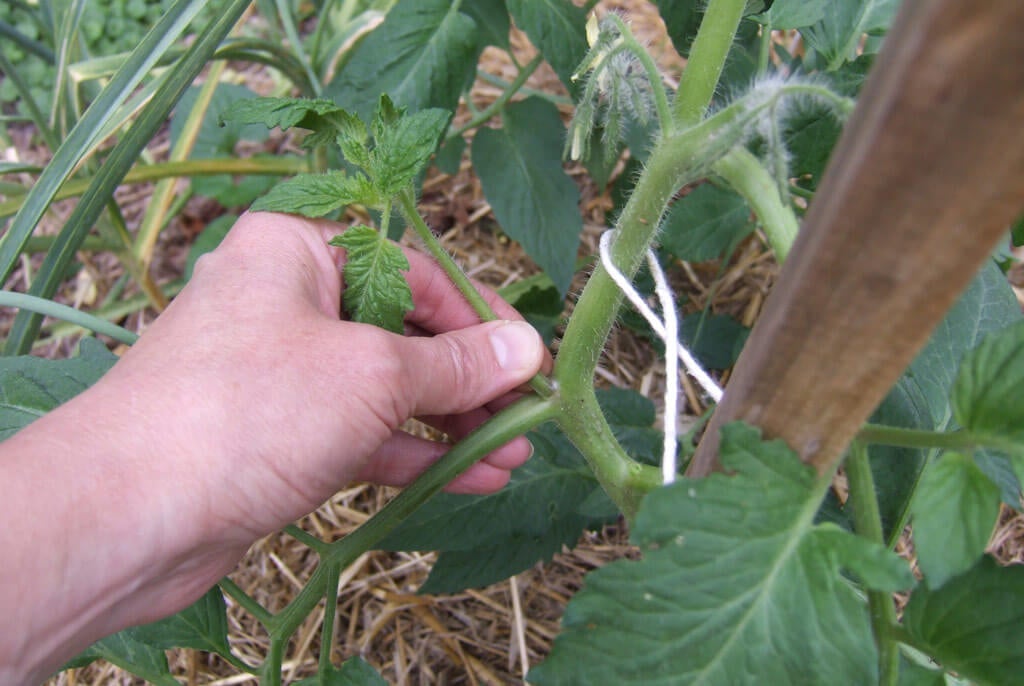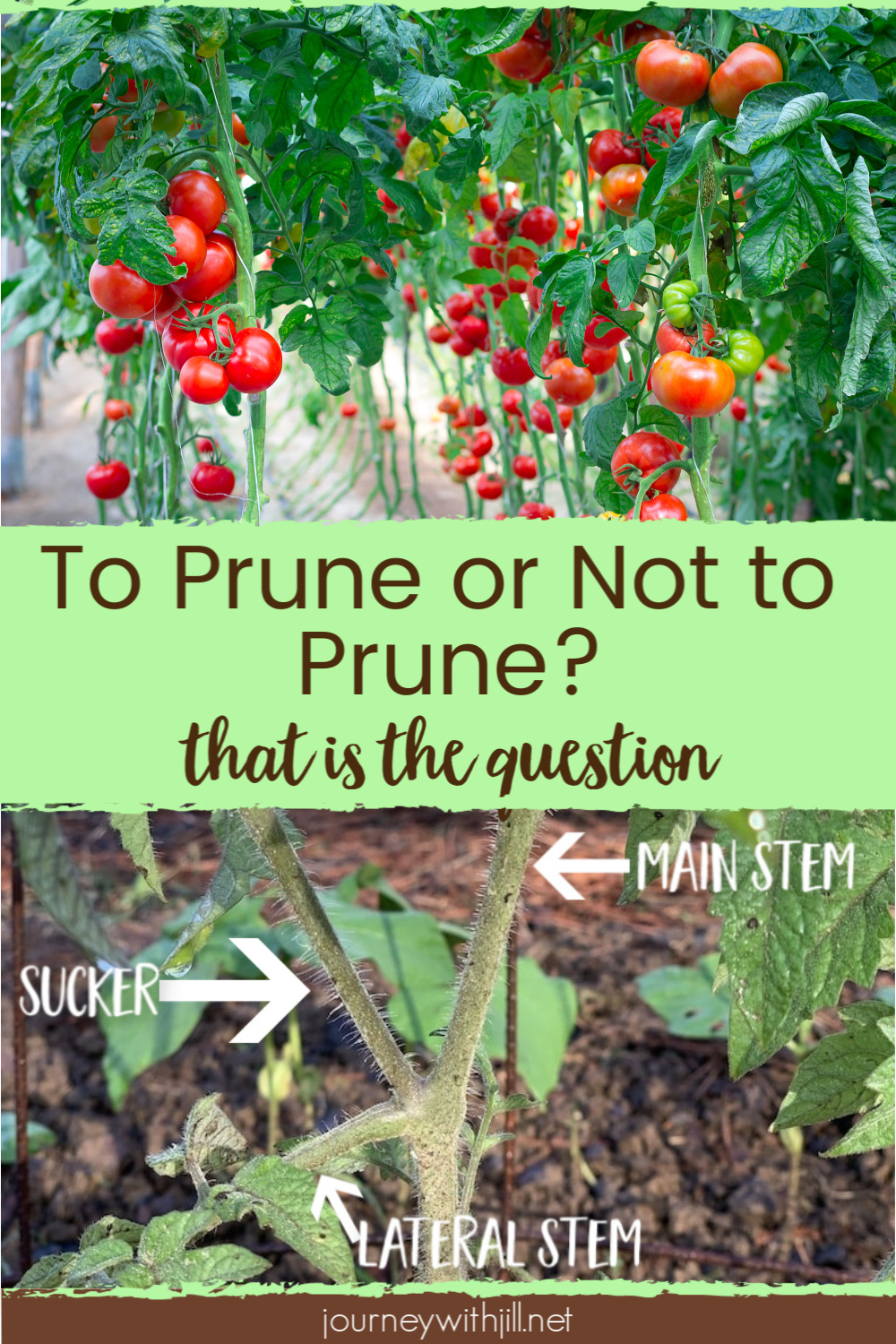Prune your tomato plants weekly. Regular pruning promotes better air circulation and healthier growth.
Tomato plants benefit greatly from regular maintenance. Pruning helps manage their growth and ensures optimal fruit production. Removing unnecessary leaves and suckers directs energy to fruit development. This practice also improves air circulation, reducing the risk of disease. Weekly pruning keeps your plants in check and encourages vigorous growth.
It’s essential to use clean, sharp tools to prevent damage and infection. Always prune in the morning when plants are hydrated. Consistent care leads to a bountiful harvest. Healthy, well-pruned plants produce more flavorful and abundant tomatoes. Regular attention and proper pruning techniques ensure your tomato plants thrive throughout the growing season.
:max_bytes(150000):strip_icc()/how-to-prune-a-tomato-plant-2540019-color-14aa314784fc4b13a5a45074c0fd8d23.png)
Credit: www.thespruce.com
Importance Of Pruning
Pruning your tomato plants is essential. It keeps them healthy and productive. Regular pruning removes excess leaves and branches. This allows the plant to focus its energy on producing fruits. Let’s explore the benefits of pruning in detail.
Boosting Plant Health
Pruning helps keep your tomato plants healthy. It removes dead or diseased branches. This prevents the spread of diseases. Healthy plants grow better and stronger.
Pruning also improves air circulation. Good airflow reduces the risk of fungal infections. Fungal infections can harm your plants. Better air circulation keeps the plants dry and healthy.
Enhancing Fruit Production
Pruning enhances fruit production. It directs the plant’s energy to the fruits. Fewer branches mean more energy for growing tomatoes. You get bigger and juicier tomatoes.
Pruning also exposes the fruits to more sunlight. Sunlight helps tomatoes ripen evenly. You get tastier and more colorful tomatoes.
Here is a simple table to summarize the benefits:
| Benefit | Description |
|---|---|
| Boosting Plant Health | Removes dead branches and improves air circulation |
| Enhancing Fruit Production | Directs energy to fruits and improves sunlight exposure |
Regular pruning is key to healthy and productive tomato plants. Follow these tips for the best results.
Best Time To Prune
Pruning tomato plants at the right time ensures healthy growth and abundant fruit. Knowing the best time to prune will help your plants flourish. Here’s a guide on the optimal times for pruning your tomato plants.
Early Growth Stage
During the early growth stage, focus on removing the lower leaves. This helps prevent diseases and improves air circulation. Prune any suckers that develop between the main stem and the branches. These suckers drain energy from the plant, reducing fruit production. Use clean, sharp scissors for this task. Be gentle to avoid harming the plant.
Fruit Setting Stage
At the fruit setting stage, pruning becomes crucial. Remove any yellowing or diseased leaves to keep the plant healthy. Ensure the plant focuses its energy on growing fruit, not leaves. If needed, prune some of the side stems. This helps the plant direct nutrients to the growing tomatoes. Regularly check for and remove suckers. This keeps the plant focused on fruit production.
Here is a quick reference table for pruning:
| Stage | Actions |
|---|---|
| Early Growth | Remove lower leaves, prune suckers |
| Fruit Setting | Remove yellow leaves, prune side stems |
Tools You Need
Pruning your tomato plants helps them grow healthy and strong. To do this well, you need the right tools. Using the correct tools makes the job easier and safer for your plants. Let’s explore the essential tools you need.
Pruning Shears
Pruning shears are a must-have for trimming tomato plants. They allow you to make clean cuts. This reduces the risk of damaging the plant. Look for shears with sharp blades. Sharp blades ensure a clean cut, which is better for the plant’s health.
- Bypass Pruners: These are great for precise cuts.
- Anvil Pruners: Use these for cutting thicker stems.
- Ergonomic Handles: Choose shears with comfortable handles to avoid hand strain.
Sanitizing Equipment
Sanitizing your tools is crucial to prevent spreading diseases. Dirty tools can transfer harmful bacteria and fungi to your plants. Always clean your tools before and after use.
| Sanitizing Equipment | Purpose |
|---|---|
| Alcohol Wipes | Quick and easy way to clean blades. |
| Bleach Solution | Mix one part bleach with nine parts water. |
| Soap and Water | A mild option for regular cleaning. |
Use these tools to keep your tomato plants healthy and thriving. Happy pruning!
Step-by-step Pruning Guide
Pruning your tomato plants helps them grow strong and healthy. Follow this step-by-step guide to keep your plants in top shape. Proper pruning ensures better air circulation and sunlight exposure.
Identifying Suckers
Tomato plants grow suckers at the stem’s junctions. These small shoots can drain energy from the main plant. Identifying and removing suckers is crucial for a healthy tomato plant.
Steps to identify suckers:
- Look where the leaf stem meets the main stem.
- Find small shoots growing in these spots.
- These shoots are the suckers you need to remove.
Removing suckers helps the plant focus on producing fruit. Use sharp scissors or pruners for a clean cut.
Removing Lower Leaves
Lower leaves can be prone to diseases. Removing them can improve air circulation. This step is essential for keeping your tomato plants healthy.
Steps to remove lower leaves:
- Find leaves that touch the ground.
- Check for yellow or brown leaves.
- Use sharp scissors or pruners to cut these leaves off.
Removing these leaves reduces the risk of disease. It also helps the plant focus on growing fruit.
Consistent pruning keeps your tomato plants thriving. Follow this guide for the best results.
Frequency Of Pruning
Pruning tomato plants is essential for a healthy, bountiful harvest. Knowing how often to prune can make all the difference. Regular pruning helps control plant size, improve air circulation, and boost fruit production.
Weekly Inspections
Weekly inspections are crucial for maintaining your tomato plants. Check for any dead or yellow leaves. Remove them to keep plants healthy. Look for suckers growing between the main stem and branches. Pinch them off to direct energy to fruit production. Regular checks help catch issues early, preventing bigger problems.
Seasonal Adjustments
Adjust pruning frequency based on the season. In early spring, prune lightly to promote growth. During peak growing season, prune more frequently. This helps manage the plant’s shape and size. As the season ends, reduce pruning. Focus on removing dead or diseased parts to prepare for the next cycle.
| Season | Pruning Frequency |
|---|---|
| Early Spring | Light Pruning |
| Peak Growing Season | Frequent Pruning |
| End of Season | Minimal Pruning |
- Weekly Inspections help catch issues early.
- Seasonal Adjustments ensure optimal growth and health.
Pruning tomato plants regularly ensures a healthy, productive garden. Follow these guidelines for best results.

Credit: bonnieplants.com
Common Pruning Mistakes
Pruning tomato plants is essential for their health and productivity. However, many gardeners make common mistakes that can harm their plants. Understanding these mistakes can help ensure a bountiful tomato harvest.
Over-pruning
Over-pruning is a frequent mistake among gardeners. Removing too many leaves can stress the plant. Stress can lead to a decrease in fruit production. Leaves are crucial for photosynthesis, which fuels the plant’s growth. Removing too many leaves limits the plant’s energy supply.
It’s important to prune only the necessary parts. Focus on removing suckers and dead leaves. This approach helps the plant stay healthy and productive. Over-pruning can also make the plant susceptible to diseases. Less foliage means less shade, causing the soil to dry out faster.
Ignoring Sanitation
Sanitation is crucial in tomato plant pruning. Using dirty tools can spread diseases. Always clean your pruning shears before and after use. This practice prevents the transmission of harmful pathogens.
Keep an eye on your plants for any signs of disease. Remove and dispose of infected leaves and stems immediately. Neglecting sanitation can lead to widespread plant infections. Healthy plants are more likely to produce a good harvest. Follow proper sanitation practices to ensure your tomato plants thrive.
Below is a quick reference table summarizing common pruning mistakes:
| Common Mistake | Impact | Prevention |
|---|---|---|
| Over-Pruning | Stress and reduced fruit production | Prune only necessary parts |
| Ignoring Sanitation | Disease spread | Clean tools before and after use |
Benefits Of Regular Pruning
Pruning your tomato plants regularly offers many benefits. It helps your plants stay healthy and grow better. Regular pruning can lead to more fruit and fewer problems.
Disease Prevention
Regular pruning helps prevent diseases. Removing old leaves stops the spread of fungi and bacteria. Fewer leaves mean fewer places for pests to hide. Healthy plants are less likely to get sick.
Improved Air Circulation
Pruning improves air circulation around your plants. Better air flow keeps the leaves dry. Dry leaves are less likely to get diseases. Good air flow also helps your plants grow stronger.
Tips From Experts
Pruning tomato plants can boost their health and fruit production. Experts provide valuable insights to guide you.
Regional Considerations
Location plays a significant role in how often you should prune. Different regions have varying climates that affect plant growth. Here are some tips based on regional differences:
- Warm Climates: Prune more frequently to allow airflow and prevent diseases.
- Cool Climates: Prune less often to retain warmth and protect the plants.
- Humid Areas: Regular pruning helps prevent fungal infections.
Variety-specific Advice
Different tomato varieties require different pruning schedules. Here’s a quick guide:
| Variety | Pruning Frequency |
|---|---|
| Determinate | Prune sparingly, focus on removing suckers below the first flower cluster. |
| Indeterminate | Prune weekly to manage growth and encourage fruit production. |
Always consider the specific needs of your tomato variety. Proper pruning can lead to healthier plants and better yields.

Credit: journeywithjill.net
Frequently Asked Questions
How Often Should You Prune Tomato Plants?
Prune tomato plants every 1-2 weeks. Regular pruning helps manage plant growth and improves fruit quality. Remove suckers and any diseased or damaged leaves.
What Are The Benefits Of Pruning Tomato Plants?
Pruning tomato plants improves air circulation and sunlight exposure. It helps prevent diseases and increases fruit production. Proper pruning leads to healthier and more productive plants.
When Is The Best Time To Prune Tomato Plants?
The best time to prune tomato plants is in the morning. Prune during dry weather to prevent disease spread. Start pruning when the plant is young.
How Should I Prune Indeterminate Tomato Plants?
Prune indeterminate tomato plants by removing suckers and lower leaves. Focus on maintaining one or two main stems. Regular pruning helps manage their vigorous growth.
Conclusion
Pruning your tomato plants regularly ensures healthy growth and a bountiful harvest. Aim to prune every week or two. This practice helps in removing unnecessary foliage and promotes better air circulation. By following these tips, you’ll enjoy tastier and more abundant tomatoes.
Happy gardening!
